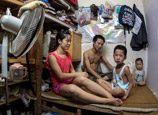
The National Bureau of Statistics announced on Monday a slower economic expansion in the second quarter. GDP growth moderated to 7.5 percent from 7.7 percent in the first quarter.
Total social financing in the first half exceeded 10 trillion yuan ($1.6 trillion), according to the central bank.
"The economy is not short of liquidity, but it requires a more efficient allocation of credit to the real economy and productive sectors as opposed to circulating within the financial system for regulatory arbitrage," said Chang Jian, China economist with Barclays Capital.
Money supply growth fell to 14 percent year-on-year in June, from 15.8 percent previously, which reflects the PBOC's policy bias for tighter liquidity in the second half compared with earlier in the year, according to Chang.
"Total outstanding credit has reached 68 trillion yuan. If we can raise the circulation of credit by 0.1 time each year, or shorten the average lending tenure by about one month, there would be extra loans of 6 to 7 trillion yuan," Chang added.
A senior executive at Industrial and Commercial Bank of China Ltd said: "The space for credit circulation and restructuring is very huge."
On July 5, the State Council released 10-point guidelines on how monetary and financial policy can stabilize growth and reduce financial risk.
The guidelines said that misallocation of capital is hampering economic restructuring.
They called for more credit support for upgrading, consumption and urbanization.

















 College student car models show youthful vigor
College student car models show youthful vigor


![]()
